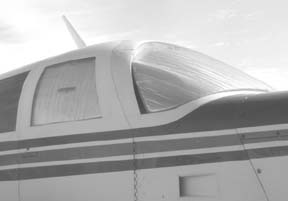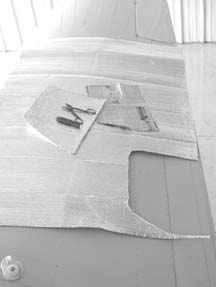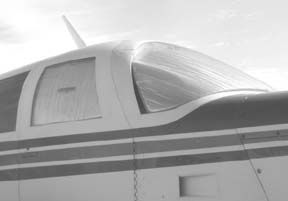
Having tumbled into some rat hole of a research project recently, we followed a couple of hundred links to this interesting but potentially useless fact: The USDA recommends that rare beef reach a temperature of 145 degrees F. Our crack research and testing department reminded us that we had seen that number somewhere before and a little digging turned up the source: Believe it or not, its how hot your glareshield can get on a high summer day after the airplane has been baking for several hours. (And yes, weve actually measured the temperature.)
Yet even though you can nearly broil steaks in most airplanes by July, the vast majority of owners don’t bother with sunscreens or cabin covers of any kind. These are the same owners who will think nothing of dropping $45,000 into new avionics, leather upholstery and fresh paint only to let the stuff bake day in and day out. Frankly, we don’t get it.
There are three good reasons to have sunshields or a cabin cover; any one of them is enough justification to buy a set. First, comfort. A sun-shielded cabin will be 40 to 50 degrees cooler on a hot summer day and it wont be heat soaked, so when you open it up and taxi, it will be not just tolerable, but comfortable.
Second, UV protection. Ever see a faded and cracked glareshield or seat covering? They get that way because the plastic or fabric hasnt been made that UV wont eventually attack, some more than others. Last, avionics.Extreme heat is bad for the radios and displays and although we know of no direct correlation between cabin heat and avionics failures, less heat is better than more heat.
Cover or Shields?
Weve always favored cabin covers over sunshields because the former provides all the heat protection of the latter in addition to covering the exterior and keeping a portion of the paint protected from sun, rain and ice. Thats a good thing. On the other hand, covers are heavy, they can be a nuisance to install when its rainy, dark or windy and they represent a sodden lump in the baggage compartment if you take them along.
Sunshields are lighter, they stay dry and are easier to handle regardless of the weather. Some owners have covers for homebase and sunshields for use when traveling, a solution that makes sense to us if you don’t want to schlep the cover.
What should good sunshields do? Thats easy. Keep the cabin cool, be easy to install and stay put and survive the rigors of removal and life in the baggage compartment. Of these criteria, we think installation ease is the top priority because if the shields are pain in the butt to put in place, you wont use them so you might as we’ll not bother buying them. Let the airplane simmer and be happy.
The market hasnt changed much since the last time we reviewed sunshields some seven years ago. In our previous review, we determined that once in place, there’s not much measurable difference in shield performance; all of the brands knock the mid-day inside cabin temperature back 30 to 50 degrees less than it would be without the shields.
We asked for samples from four suppliers of sunshields to fit our Mooney 231 and from Sportys, we bought a sheet of plastic-cell insulation intended as a do-it-yourself kit. We popped these into the airplane windows, checked the fit and photographed the results.
Cunningham Aircraft Covers
Two of the major cover makers-Cunningham and Kennon-also make sunshields as allied products. Both of these companies have a deservedly good reputation and weve found them to be excellent to work with over the years. As are most of the shield products, the Cunningham shields are made of a foil-covered, bubble-pack type insulation material with an outer coating of clear polyester to prevent scratching.
The edges are hemmed in Sunbrella acrylic plastic and attention to detail is first-rate throughout. Since shields are pretty much shields, what matters most is fit, fastening method and whether the biggest shield-the windshield portion-is a single piece or two pieces. We prefer the latter for reasons we’ll get to in a moment.
The Cunningham shields were accurately fitted to the Mooneys windows and slip into place with minimum hassle. They have a single clear plastic tab along the top of the window that slips under the liner as a failsafe against falling out. This works quite well, in our view. Cunningham uses a two-piece windshield design which is altogether easier to install, given the Mooneys mid-windshield downtube. Ours is further constricted by the ridiculous installation of a glideslope antenna at the top of the tube. Yet even with all this junk in the way, the Cunningham shields slipped right into place.Each shield is labeled on the inside so its easy to tell which is which.
Cunninghams covers are priced at $175 for singles and light twins, including shipping, and include a nylon carrying case with a drawstring.Rolled for storage, the case is 28 inches long and about 10 inches in diameter.
Kennon Aircraft Covers
The Kennon shields are similar in design to those from Cunningham, with a two-piece windshield shield and individual labeled pieces for each window. The shield material and piping are identical to the Cunningham products but instead of a single plastic tab, the Kennon shields have four tabs, one in each corner.
We found that the fit was generally good but not quite as accurate as the Cunningham covers and this made getting the plastic tabs locked into the window liner a bit more difficult. The windshield pieces were slightly overlarge and didnt fit easily into the tight corners between the windshield and glareshield. However, if there’s a fit problem, Kennon is more than happy to adjust the fit size, as they are with their covers.
Rolled size is similar to Cunningham covers and a drawstring bag is provided. One of the large windshield pieces is fitted with a Velcro strap to keep the rolled shields contained, which makes it easier to stow the shields and get them into the bag. Price is $185 for singles and small twins.
Sun-Foil Aircraft Sun Screens
Sun-Foil is unique for offering two grades of shields and you can buy just a cockpit set or a full set. A cockpit set covers the windshield and side windows while a full set covers all of the windows. What Sun-Foil calls its Poly-Guard product is similar to offerings from Kennon and Cunningham. For an extra charge, Sun-Foil will laminate a layer of gold Mylar on top the silver foil. For singles, a cockpit set costs $155 in silver Poly-Guard and $195 with the optional Mylar. A full set is $185 and $265, respectively. In our view, the Mylar versions win the beauty contest. The shiny gold surface gives these shields a space-age look that we found attractive, although were not sure all owners will deem it worth a $40 to $80 price premium over the silver shields. Sun-Foils Julie Schaedel told us 95 percent of customers opt for the Mylar both for looks and because the shields are more wear resistant.
The fit in our 231 was good and the fastening method used-small suction cups at the corners of each shield-held the devices in place with no apparent marring or marking of the window. We did encounter one fitting problem. The Sun-Foil windshield screen is a single piece and with our glide-slope antenna obstructing the area between the downtube and the windshield, there’s no way the screen would fit. Sun-Foils Schaedel told us the single-piece windshield screen could be made in two pieces if the customer specified that and we would recommend it be done, even for airplanes without down tubes. The Sun-Foil shields roll up and store in a drawstring bag thats about the same size as the Kennon and Cunningham bags.
Cee Bailey
We examined another sunshield product from Cee Bailey. Although the companys Web site shows the Mooney 231 on the product list, we were unable to obtain a sample set so we asked for a sample for a Cessna 172. Construction is similar to the Kennon and Cunningham products and you can specify any of 12 colors for the edge banding. You can also buy just a windshield screen instead of the full set.
These shields are less expensive than the competition, according to the Web site, with most models selling for $125 for a full set, plus $35 for a custom edge treatment color. A drawstring bag is a standard accessory. Cee Baileys 172 shield is two pieces, one of which is equipped with a Velcro strap for securing the rolled shields in the bag. The side window screens stay in place with an interference fit, no suction cups or tabs. We wonder how this design will hold up as the shields wear and become more flexible. We think the tabs or suction cups are a better idea for long-term fit.

Sportys DIY
For years, Sportys has sold sheets of the same insulating material the other makers use to construct custom sunshields. The idea is that from a single sheet of this stuff-it sells for $11.50 a yard-you can make your own shields for a fraction of the cost of custom products. Plan on about four yards of material or about $50 or so. Sportys recommends Velcro coins to hold the shields in place.
But there’s a drawback. Actually, two drawbacks. The Velcro coin mounting method isn’t our first choice because the coins heat up and the adhesive eventually makes a bit of a mess on the windshield or the window liner.Second, as Sportys plainly says in the catalog, there is a possibility that [this material] may scratch Plexiglas.
And theyre right. We had no trouble scratching the windows with this stuff by rubbing it against an out-of-the-way corner of the glass. The scratches were small but visible nonetheless. In fairness, scratching can be avoided with careful handling but given the work of cutting your own shields-that takes an hour or so-and the fact that they have no edge piping, the savings might not be worth the effort for some owners.
Sportys also sells a flexible material called TXG laminate for do-it-yourself shields ($14 a yard, three to four yards needed) or $95 for a custom set of shields. Weve tried this product in the past but did not re-test it for this article. The TXG has the advantage of being lighter than the other shields and, being a fabric, will store in smaller volume. But it requires Velcro coins to mount and, for the aforementioned reasons, we prefer to avoid Velcro for this purpose. If you don’t mind the Velcro goop, these are a moderate cost and lightweight alternative.
Recommendations
Of all the shields we tried, none had what we would call bad fit or mounting methods but the Cunningham had the best of both, in our view. Thermally, all perform about the same. On price alone, the Cee Bailey shields are impressive, at some $50 less than the closest custom-made competition.
However, the Cee Bailey products lack the finer details of tabs or suction cups so long-term fit is less certain. If you wish, you can buy from Cee Bailey just the windshield screen, which will reduce cockpit temperature substantially, although not as much as full set. But in our view if youre going to protect the airplane, protect it. Buy a full set.
Although theyre expensive, we like the Sun-Foil Mylar products. They look terrific and have a high-quality, well-made feel. Our only reservation is how we’ll the suction cups hold up with repeated use. We welcome feedback from long-term owners of Sun-Foil screens.
As for the Sportys roll-your-own screens, this approach is certainly suitable for an airplane that doesnt fly much or one for which custom shields arent available. But for frequent use, we think owners will want the scratch-protective polyester coating and tabs or suction cups to assure hassle free-fastening as the shields age and become more flexible. Also, edge piping will increase the durability of shields and the roll-your-own choice lacks this feature.
Also With This Article
“Checklist”
“Shield Fastening Methods”
“Sun Shield Downsides?”
Contacts
Cunningham Aircraft Covers, 800-940-03426, www.cunninghamcovers.com
Kennon Aircraft Covers, 800-356-0809, www.kennoncovers.com
Sun-Foil Aircraft Screens, 800-328-1232, www.sunfoil.com
Cee Bailey Aircraft Plastics, 800-788-0618, www.ceebaileys.com
Sportys Pilot Shop, 800-359-7794, www.sportys.com


